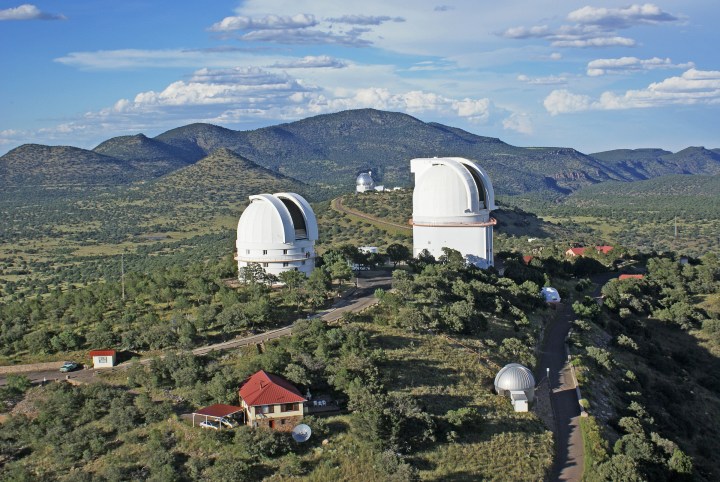
In West Texas, astronomers worry about growing oilfield light pollution
In West Texas, astronomers worry about growing oilfield light pollution

In a rural corner of West Texas, hours away from the bright lights of big cities, the night skies are so dark that you can sometimes see the Milky Way from your backyard.
But oilfield activity near this pristine part of the state has been growing in recent years, and astronomers are warning about increased light pollution that’s come along with it.
“The stars at night are big and bright, deep in the heart of Texas,” goes the popular old song that’s a kind of Lone Star State anthem. But these days, it’s pretty hard for most Texans to see the stars, as around 85% of the state’s population is located in rapidly-growing urban areas.
Bill Wren is one of the lucky few.
He lives and works at McDonald Observatory, perched on a mountaintop in the state’s rural Big Bend region, where the night skies are still pitch black, and the stars are about as bright as they come.
“Yeah, we have to suffer through this, day after day,” Wren joked while looking out over his sprawling view of the Davis Mountains. About an hour away is the nation’s largest oilfield, the Permian Basin. Because oil drilling is a 24/7 business, astronomers here have grown increasingly concerned about all the lights on drilling rigs, trucks and gas plants.
“For the past, you know, 12 years or so, we have seen a gradually increasing glow that simply wasn’t there in prior years,” Wren said.
Wren is a kind of dark skies salesperson for the observatory. He travels the oilfield trying to convince companies to point their lights down or use different kinds of bulbs. He said it hasn’t always been an easy sell.
“First day I stepped foot on an oil rig, I was told, ‘You can’t have too much light on an oil rig, it’s a very dangerous environment,’” he said.
Safety is indeed a key concern, according to local oilfield foreman Caleb Taylor, who works in the area.
“The lighting we have is big halogen, sodium lights, and they point them in all directions to pretty much cover the whole pad,” he said.
Wren’s pitch to the oil industry is that bright lights don’t always mean safer lights. He often asks industry representatives a simple question:
“What if that bright light is shining directly into your eyes, creating glare, and you can’t see because of it?” he said.

Some oil and gas firms have embraced his message. At an Altus Midstream gas plant, facilities manager Austin Williams described the company’s specialized lighting.
“There’s a small shield that kind of focuses the light beams to force their way downward, instead of letting it spread and pan out,” he said.
According to the company, there’s no extra cost to designing facilities this way. But retrofitting old sites with new lights could be a different story.
“There’s hundreds of thousands of these light units that they would have to change, and nobody likes to do stuff that costs money,” said Taylor, the local oilfield foreman. “You know, that’s going to be a deterrent.”
In Reeves County, one of the most active parts of the Permian Basin oilfield, local officials recently adopted new rules requiring companies to update all outdoor lights to tougher standards within five years, and to shield some lights within six months of the effective date, May of this year. The rules come with a possible $500 fine.

Curtis Wilson, the county staffer in charge of enforcing the rules, said he’ll go after companies if there’s a complaint, but he said a lot of the compliance will be voluntary.
“I don’t expect they will go into existing facilities and update them, they might,” he said. “What I do expect is that the new constructed facilities will be shielded properly.”
Hanging over these efforts to preserve dark skies is the fact that oil prices are higher than they’ve been in more than two years, and there’s talk of even higher prices on the way. That could mean more drilling, more lights, and light pollution becoming less of a priority.
Still, McDonald Observatory’s Bill Wren said he thinks encouraging companies to play along is the best way to go.
“It’s going to happen by showing people that it’s in their benefit, it’s not going to happen by enforcing an ordinance,” he said.
And he said there isn’t any actual goal post for reducing light pollution — any little bit helps protect the observatory’s research.
There’s a lot happening in the world. Through it all, Marketplace is here for you.
You rely on Marketplace to break down the world’s events and tell you how it affects you in a fact-based, approachable way. We rely on your financial support to keep making that possible.
Your donation today powers the independent journalism that you rely on. For just $5/month, you can help sustain Marketplace so we can keep reporting on the things that matter to you.

















